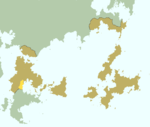Keadaan Matang
 |
 |

| |
| Country | Sokoku |
|---|---|
| Capital | Siraya |
| Area | 25,098 km2 km2 |
| Population | 2,767,878 |
| Density | 111 per km2/km2 |
| Demonym | Pakatayan |
| Time zone | UTC-9 |
Keadaan Matang is a member state of Sokoku. It entered the federation in 76XX as the 5th member. After Mirei it is the least populated and smallest of the member states.
Etymology
'Keadaan Matang' literally means "mature state" and was the name of the political movement that took power after the first democratic elections following independence in 76XX. Mature state refers to the movement's philosophy of a new state without colonial or loyalist influences, formed after the example of Sokoku. So when the Keadaan Matang government applied for membership of Sokoku it did so under the political name of the government and not the geographical name of the region, being Pakatayu. However, the denonym pakatayan is still in use due to the lack of a useful alternative.
History
Pre-colonisation
Nelyasyat was first settled by humans around 15,000 years ago by peoples migrating south from Southern Altaia. Favourable agricultural conditions as a result of the rich volcanic soil on the island, as well as mastering wet-field rice cultivation around the early third millenium RH, allowed towns and small kingdoms to flourish and develop on the island by the fourth millenium.
Lizehanist religions arrived in the region from the 68th century, when the naval kingdom of Tepaananan built its extensive trade networks from the north. At about the same time, trade started with the Tsuki Integrality from the east.
By the early 8th millenium Anarian explorers were discovering lands across Altaia. They entered a region devastated by natural disasters (including increased volcanic activity as a consequence of the Julian Event) and torn apart by waning empires trying to keep control over the lands. Under those circumstances, the Anarians had it relatively easy to start and settle on Nelyasyat.
Establishment of Colonial Rule
Traders from Livarya, Casella, Halland and Helreich explored the coasts and tried to set up trading relations with the Kingdom of Pakatayu. The region was however difficult to reach for Anarian traders due to its location bordering an inland sea. So external trade with Anarians happened every now and then, while colonisation took place further north and west on Nelyasyat. In 7256 the colonial government was overhauled, with the six semi-autonomous colonies that made up Casellan Radhria unifying under the single Aspasian Colonial Government (Anisoran: Aspasiane Governo Coloniale), headquartered at Giulicannia. Aspasia proper was divided into nine mainland states and one special administrative island (Salakan), ruled by the Admiralty. Pakatayu became a Colonial Principality, nominally ruled by Pakatayan nobility but in reality under colonial rule.
Aspasian colony
While colonial rule was extended over a larger territory and intensified, it was inevitable that wars with local kingdoms and rebellions among semi autonomous states within the colony occurred. In Pakatayu the most illustrious events were the Nytalayan Rebellion (7545-7546) and Pakatayan Secession (76XX).
The Nytalayan Rebellion, also known as the 'Southern Aspasian Mutiny ran from early 7545 to late 7546. It was an armed conflict between the Anisoran Colonial Government of Aspasia and a coalition of local native leaders led by Prince Rulakanea, Rallan of Pakatayu. The conflict was primarily fought in the southern states of Aspasia, where the largest associated principalities are located. The rebellion was named after the first settlement attacked by the rebels. Main reasons were the increasing number of Anisoran settlements in the south, replacing the local population, the lack of local representation within the Colonial Government of Aspasia, as well as the use of excessive force by the Anisorans to exact taxes from rural populations in the southern states and towards industrial workers not reaching quotas set by the Viceroy's Office.
Three months after the start of the rebellion, where the majority of the Anisoran military had been forced out of Pakatayu, the rebels ambushed Anisoran reinforcements during the Battle of Killay Valley. The battle saw a catastrophic Anisoran defeat, with over 6,000 casualties. Many other important towns in the eastern states of Matillanu and Miamoru were stormed and sacked during this period of Anisoran retreat. The Anisoran changed tactics, avoiding large concentration of troops and almost surgically reclaiming territory. This culminated in the retaking of Matillanu, where the rebel's main force was defeated with huge naval support. Prince Rulakanea retreated south into the Massinuza Mountains where he was finally killed on 19th September 7546. The Southern Principalities which took part in the rebellion were preserved with the vitally important Principality of Pakatayu given to Prince Rulakanea's niece Sakayana. She was to rule with an Anisoran and local Pakatayan advisor, but the territory, along with many other principalities in south and east, was given considerable autonomy as well as seats in the newly created Senate.
Pakatayan secession
With the death of Sakayana in 76XX, local leaders saw an opportunity to spark Pakatayan secession sentiments again. The princess' successor didn't have as much popular support among the local population, which created a breeding ground for another rebellion. Secession was declared in Siraya in 76XX but was met by a quick military response from Anisoran military. But in the urban landscape of Siraya, the guerilla tactics of the secessionist led to a high rate of casualties among the colonisers. So when the secessionists formulated an ultimatum towards the Anisoran civilian population to leave the city quickly with a guarantee they would not be harmed, a lot of the military put on civilian clothing and left. When waiting for an Anisoran counterattack, attempts were made to built a national government. But soon a conflict erupted between a loyalist group gathering around Prince Ajimat, a distant cousin of Sakayana, and a group striving after a republic. Due to internal problems in Anisora and the Nytalayan Rebellion still in memory, those countermeasures took time. Instead violence erupted between the loyalists and republicans. Where the first had more support on the conservative countryside, the latter had a larger support within the cities and towns. With Anisoran production facilities up for grabs, the republican movement quickly gained momentum, being able to carry out social modernisation which the loyalists could not offer.
The Stoldavic Orderist Commonwealth however saw an opportunity to expand its zone of influence and started supplying the republican side. This led to a response from some republicans opposing orderism, reaching out to Sokoku instead for military support. So by the time an Anisoran counter offensive was started in 76XX they also had to face orderist and Sokokan factions. Instead, Anisora took a marginal presence in the periphery of Pakatayu, keeping a nominal claim to the autonomous region but avoiding full scale conflicts. Instead, the three main factions of loyalists, orderists and mireists entered a full scale civil war, battling for control over the seceded state. The conflict between Sokokan backed forces and Orderists spread to Neu Südentor, which had tried to remain a Häverist (instead of Orderist) stronghold in a reforming Commonwealth. After the Sokokan military defeated both the marginal Anisoran presence and the Orderists, a cease fire was signed with the loyalist faction. It was negotiated into a permanent peace treaty as overseen by ICoN in 76XX. It is estimated that the Pakatayan secession resulted in 18,000 to 36,000 casualties.
As part of the ICoN sanctioned treaty, free elections were held in 76XX. Where the loyalist and moderate groups voted along ethnic and political lines, republican supporters massively supported the Keadaan Matang movement. The following majority Keadaan Matang government first signed a military cooperation treaty with Sokoku and later applied for membership status within that country. This is why Pakatayu entered Sokoku as Keadaan Matang, which also stated a break with its past as a small kingdom and autonomous region within Aspasia.
Recent history
TBA